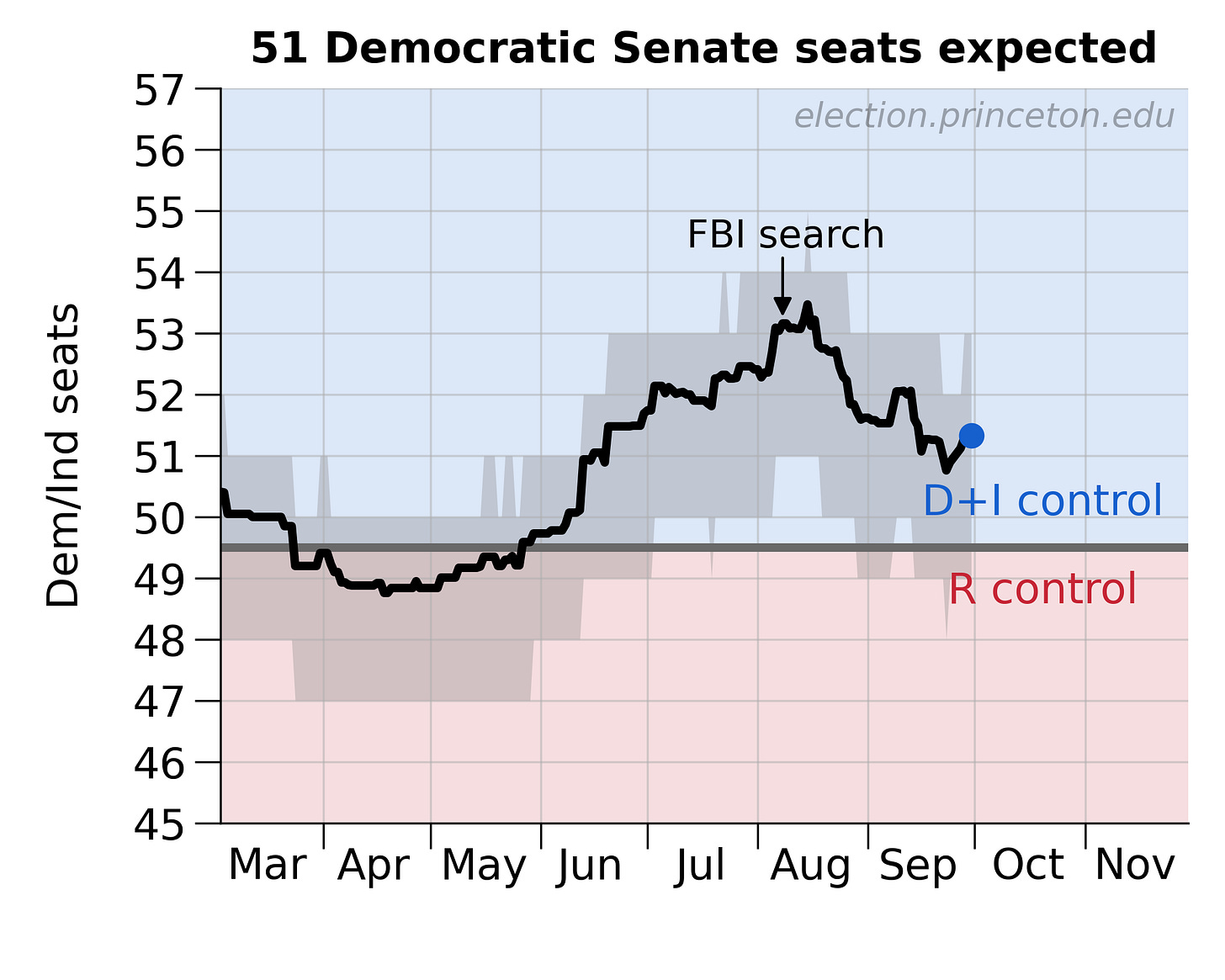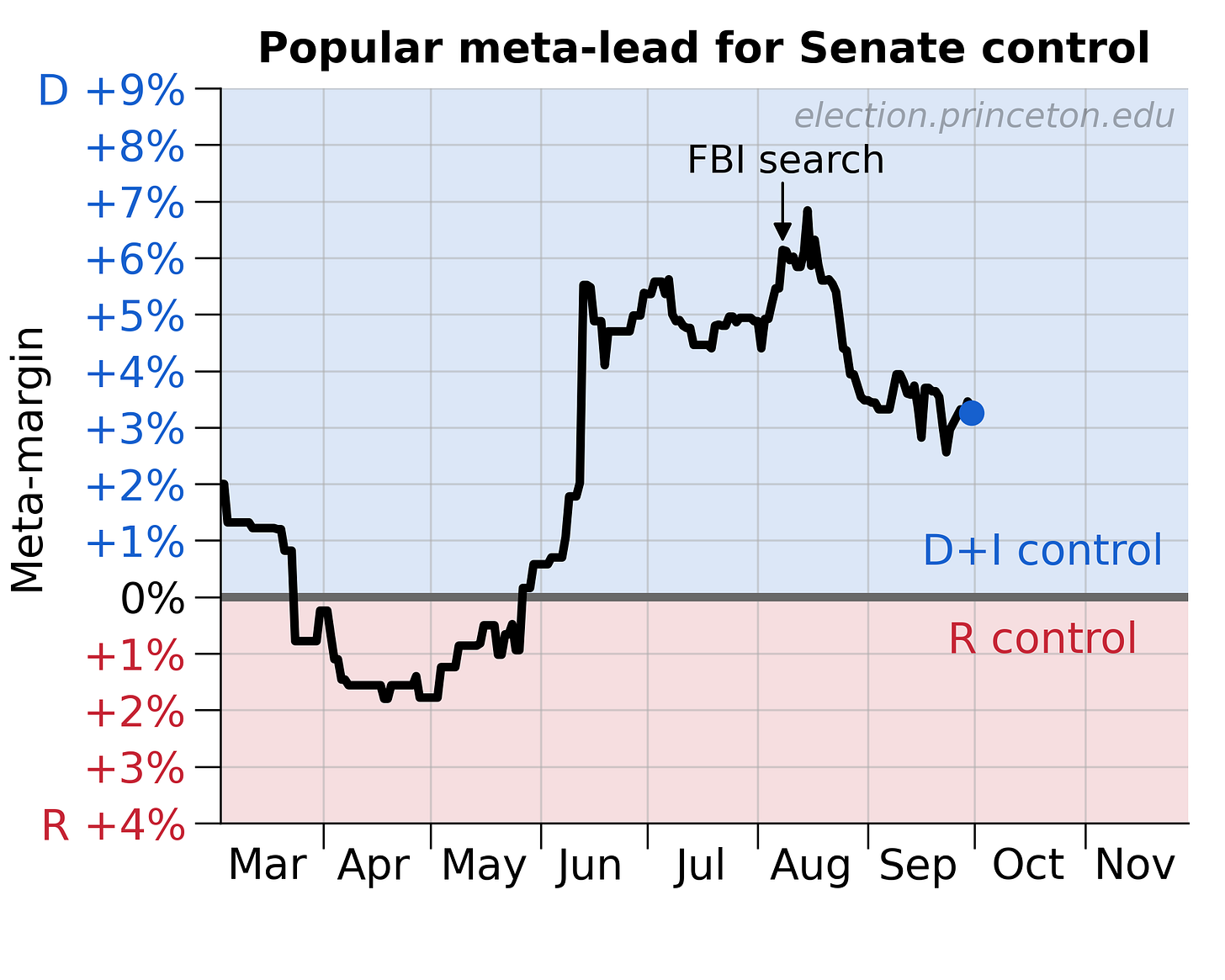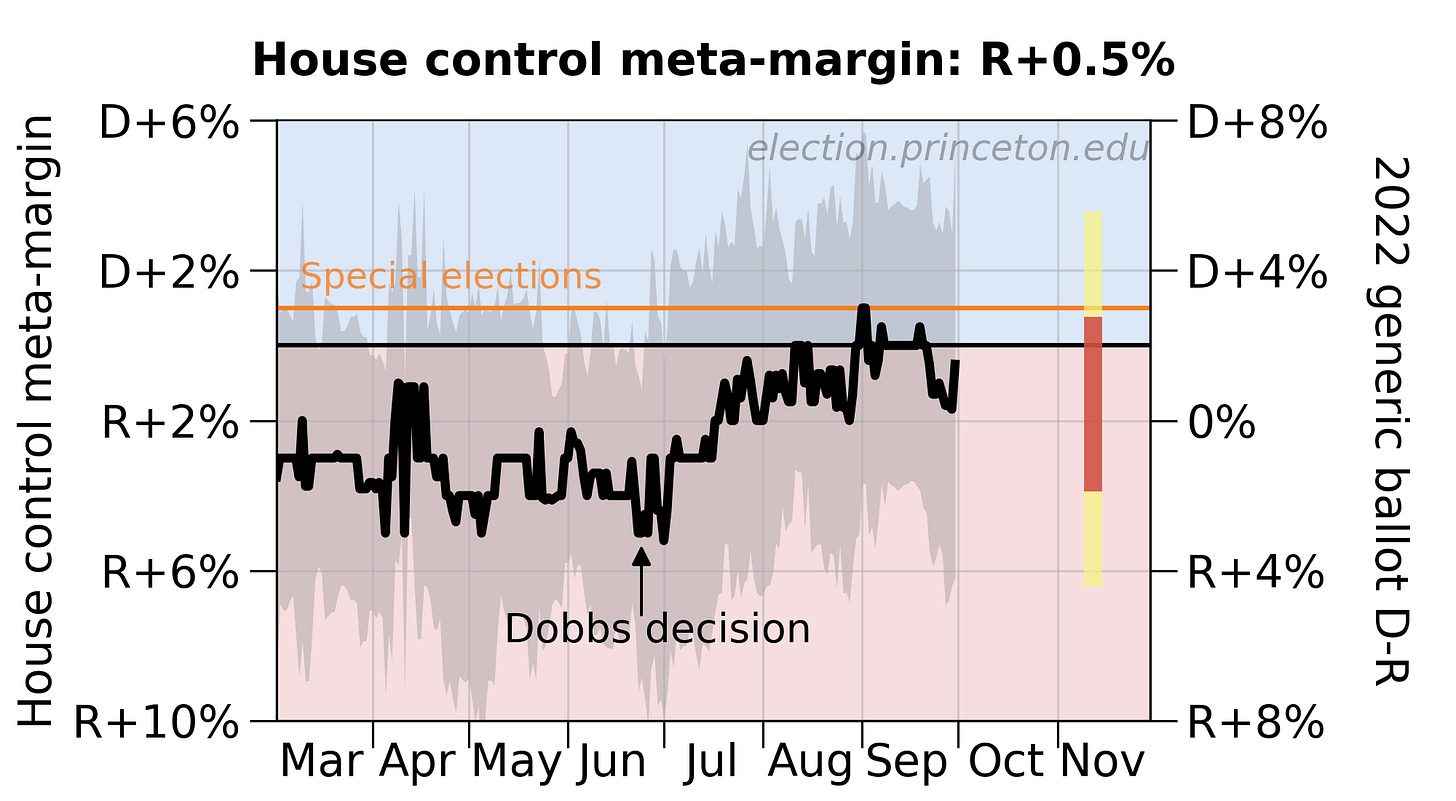Democracy Moneyball, 2022 Edition
Make your efforts more effective by a factor of a hundred or more. Part 1: The Senate.
This is the first in a three-part introduction to the concept of Democracy Moneyball.
Part 1: the Senate. Part 2: the House. Part 3: state-level races and the preservation of democracy in 2024.
I started this Substack with the goal of identifying ways to make democracy more responsive in the long term. But with the election weeks away, the short term is essential as well. Therefore I present Democracy Moneyball, the 2022 Edition.
Those of you who have read the Princeton Election Consortium over the years are familiar with this concept. As one of the earliest poll aggregators (I started in 2004), I’ve always been interested in using polling data to help voters find which races were pivotal. I started with the presidency, then expanded the Senate and House, and finally state legislative races. But my reasons were different from bigger aggregators such as FiveThirtyEight.
A fairly common use of polling data is to drive horserace coverage. In this metaphor, readers are spectators, cheering on their preferred candidate. It’s like being a sports fan. After all, Nate Silver first became well-known for his work on baseball statistics. In a sports-esque approach, oddsmaking takes a front seat.
My reasons are different: I want to help people take the most effective action with their limited time and resources.
Politics is different from sports
Politics is a game of active participation. If you feel passionate about a candidate, a party, or an issue, you can do the equivalent of run onto the playing field! You can go door-to-door or donate money, you can work for a campaign, and you can even run for office yourself. And in the long term, you can work to change the rules of the game.
But between now and November, where should you put your efforts? Elections everywhere are essential, of course. But some elections are more pivotal than others.
For example, control of the United States Senate this year hinges on eight races where the outcome is in the most doubt: Ohio, Pennsylvania, Georgia, North Carolina, Nevada, Utah, Florida, and Wisconsin. Elections there are pivotal, and one would be well advised to focus efforts there if one wants to influence who controls the Senate in 2023.
The power of your vote
The strength of a single voter’s influence can be quantified. Back in 2008, I developed a measured called “jerseyvotes,” fancifully named after the fact that as a New Jersey resident, my votes for federal races were not at all influential, no matter whether I voted for a Democrat or Republican. Under modern levels of reliability in voter behavior, New Jersey’s outcome carries little uncertainty. I defined a jerseyvote as the amount by which one New Jersey vote changed the probability of Senate control.
A few miles from here, a Pennsylvania vote was worth hundreds of jerseyvotes. Therefore a pretty effective thing I could do on Election Day was vote absentee, then go over to Yardley to drive people to go vote. Each person I drove would be worth many times as much as my puny vote.
Jerseyvotes are not only worth less, they are volatile. To make an analogy with currency, they are the equivalent of Weimar deutschemarks. and considerably worse than the current pound sterling. That’s generally true in strong Democratic and Republican states. (However, note that in swing districts, votes can still be pivotal. We’ll get to that in Part 2 of this series, on the House.)
Voter power in the eight pivotal Senate states
Here is the Princeton Election Consortium‘s calculation, which went live last week.
Currently, Democrats are favored to keep the Senate. It’s not a done deal: the gray band indicates the zone of uncertainty.
In this calculation, a key quantity is the meta-margin. That’s how much polls would have to swing overall, or be in error overall, to make control a perfect tossup. As of today, the Senate Meta-Margin is Democrats ahead by 3.3%.
That’s a fairly good margin for Democrats, but not dispositive. It’s similar to Joe Biden‘s Meta-Margin for winning the presidency on Election Eve in 2020. However, polling errors in Senate races have been rather large in the last few elections, up to seven points. Some of that error seems to be difficulty in accurately reaching all Republican-leaning voters; in 2020, some appeared to stem from Republican voters not verbalizing their downticket preference to pollsters.
If we think the one-sigma error bar on D+3.3% is 4 points, then control the Senate currently favors the Democrats by about 70-30 odds. Odds like that leave considerable suspense - and a lot of room for voter activism and donations to make a difference.
Currently, poll margins show the following pattern.
which, if you turn it into a probability distribution, looks like this:
Those 49th, 50th, and 51st seats in the table, currently Ohio, Pennsylvania, and Georgia, are going to be quite important. If polls are off by, say, 3 points, every vote in those states will be pivotal.
Mathematically, we can calculate voter power under this condition by assuming that Republicans will do better than polls by an amount equal to the Meta-Margin, 3.3 points.
The power of your donation
Relative voter power (and donation power) then looks like this:
This is pretty interesting! As expected, voters in some states with close Democratic leads have powerful voters: Georgia, Ohio, Pennsylvania, and North Carolina. But New Hampshire, Nevada, and Utah voters are even more powerful. Why is that?
The answer is population. The first four states had an average of 7.8 million votes cast in the last election, which the latter three states only averaged 1.1 million votes cast. Comparatively, voters in the small states have a lot of influence. And there’s enough uncertainty that even though polling leads are larger in the small states, we don’t really know how they will turn out. So they are worth your effort.
There are two other surprises here. Utah independent Evan McMullin lags Senator Mike Lee (R) by only three points, and they’re running in a small state, creating a hidden bargain. Conversely, in Florida, Val Demings (D) lags Senator Marco Rubio (R) by four points…but Florida is so large that moving the needle there is actually quite hard.
If you would like to act upon this, I have set up ways for you to contribute. Democrats, I give you an ActBlue site. Republicans, I give you a WinRed site.
(Note that although I offer options to both parties, I do take a stand on democracy: faith in elections and upholding an accurate vote count is foundational. Therefore these lists are curated to exclude election deniers.)
A preview of my next Substack: the House
Control of the House, which in May seemed like a foregone conclusion, has become an open question. This can be traced, with precision, to the Supreme Court Dobbs decision striking down Roe v. Wade:
The right axis shows generic polling margins, which are pretty predictive of the eventual national vote. The left axis is shifted to account for the Republican advantage in redistricting. The difference between these axes is only about 2 points, as I wrote in August (also see Nate Cohn’s recent column), which means that the U.S. House is a fairly level playing field this year. (State legislatures are a far more variable story.) If you want to know who is favored to win control of Congress, look at the blue and pink zones.
The three-point shift following the Dobbs decision wasn’t that large. But it was enough to put the House on the knife’s edge, at least from the standpoint of polling data.
There are two more features of note. The orange line shows a prediction based on special elections. Near the right edge of the plot is a “strike zone” based on polls, indicating probable outcome (in red) and full range of outcome (in yellow). So both polls and special elections point toward a real nail-biter for House control.
In the next installment of Political Moneyball I’ll write more about the House. In the meantime, if you have a favorite resource for this (or want to code up a district finder for me!), let me know in comments or be in touch.
Summary
If you care about control of Congress, both the Senate and House are worth putting in effort. These two links provide a way for you to donate, no matter what your preference.
Postscript: for math aficionados only, details on the calculation
Here is how I calculated voter power.
For the Senate, where each statewide race elects one vote in the chamber, a fairly accurate calculation of voter power can be done considering three facts: (1) Senate control is truly perched on a knife edge when the polls are off by an amount equal to the Meta-Margin. (2) We can get an estimate of what will happen in each state in November from polls. (3) If more people vote in your state, then your individual power is lower because it takes more of you to move the needle.
Using these facts, my formula for voter power is
voterpower for a state = tpdf(|statemargin-MetaMargin|/sigma,tail) / voterpop,
tpdf() is a “long-tailed” distribution which allows for the possibility of allowing for the possibility of outlier events, and tail scales with how much of the distribution piles up in the middle (see MATLAB documentation; I’m using tail=1, for the fattest tails). Statemargin is the median margin of recent polls. Sigma is how many percentage points polls might be off from eventual November results, even after averaging (currently I’m using sigma=4). Voterpop is the estimated number of voters in the state, which can be estimated from 2020 turnout.












When making a donation on the ActBlue site, the return e-mail says it's for the 2020 election. May want to update that so you don't freak people out.
So, I have a (vague) question about the philosophy of this site.
In, say, senate elections we are only allowed to vote in one state, the state of our residence.
But we can contribute money to any state - which seems a strange thing but, hey, freedom of speech I guess?
Of course, it also seems strange to me that money seems to matter so much because, after all, can't the voters make up their minds for themselves from unbiased sources?
Like, maybe I get it that in pre-internet days it took money to spread the word but nowadays plenty of websites present rather objective views for free.
So, where do you stand on money in politics? Is it closer to "a good thing" or to a "well, them's the rules so we must play that way"? And what is your view on why it matters so much? It seems to put the question to democracy that I can just blast people with biased ads and affect their votes ...
I ask these things because it seems one needs a foundation for "what is good" in order to discriminate between "bugs" and "features" of anything going on in our democracy.